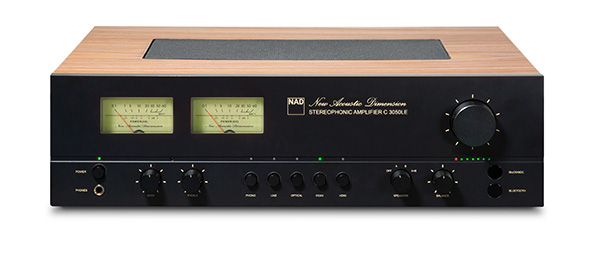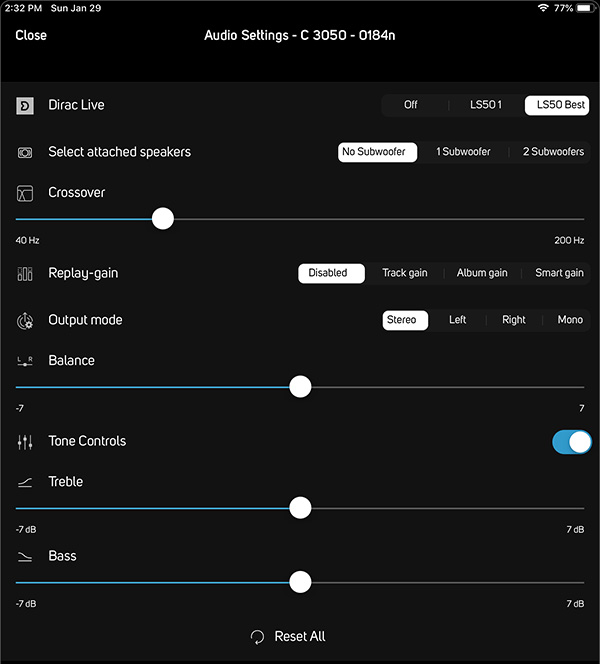| Columns Retired Columns & Blogs |
Na! shame, it could have been, they missed out on DAB/+ and Internet Radio tuners.
Cheers George

NAD was little known in 1980, but the 3020 put the brand on the map, the company selling 1.1 million units over the amplifier's lifetime. NAD subsequently went through ownership changes and in 1999 was purchased by Canada's Lenbrook Group, the brand's Canadian distributor since 1978.
Stereophile has favorably reviewed many NAD amplifiers over the decades. One of the most recent was the Master Series M10 class-D streaming integrated amplifier, which I purchased to use as my daily driver after I reviewed it in January 2020. The M10's price included a free license for Dirac Live low-frequency room equalization, which I found invaluable with my long-term reference standmounts, the KEF LS50s. So when I learned that NAD was introducing a 50th Anniversary integrated amplifier, the C 3050 LE, which also included Dirac Live, I asked for a review sample.
The C 3050 LE (Anniversary Edition)
The LE in the amplifier's name stands for Limited Edition—just 1972 samples will be sold at a US price of, you guessed it, $1972. (1972 was, as mentioned above, the year of the company's founding.) The price includes an MDC2 BluOS module. (There will be a non-LE version, which will cost $1899 with the BluOS module, $1299 without it.)

With its wood-grain vinyl wrap, the cursive-font "New Acoustic Dimension" logo on the front panel, and its twin, illuminated VU meters, the amplifier's styling is distinctly retro, resembling that of the NAD 3030 amplifier from 1976. Inside, however, the C 3050 LE is thoroughly modern. The BluOS module allows audio to be streamed from local storage on the owner's network or from Tidal, Qobuz, Amazon Music Ultra HD, Deezer, TuneIn radio stations, and other streaming services,with digital resolution up to 24bits and a sample rate of 192kHz. MQA unfolding is supported. Audio can be streamed from iOS devices with Apple AirPlay 2, and the BluOS module works with the Spotify Connect and Tidal Connect apps. Music can also be streamed from mobile devices to the amplifier or from the amplifier to wireless headphones with two-way Bluetooth aptX HD. Playback can be voice-controlled using Amazon Alexa, Google Assistant, or Apple's Siri. An IR remote control is provided, and multiroom operation and integration with smart home-control systems is supported.
BluOS is an app-based multiroom "music ecosystem" (think Roon) which provides access to your own content and integrates a large number of music services—not just the usual suspects like Tidal and Qobuz but also some obscure ones, such as nugs.net, IDAGIO, and Bugs, which is available only in South Korea. If a streaming service isn't available, you can send it to the C 3050 LE with BlueTooth or AirPlay.

The C 3050 LE accepts data via HDMI eARC, Type A USB, and coaxial and optical S/PDIF inputs. The C 3050 LE's D/A circuit uses Texas Instruments PCM5242 differential-output DAC chips. These can decode PCM data up to 32 bits and 384kHz, though the amplifier's playback is limited to 192kHz. Installed at the lower left of the back panel is the MDC streaming module (but optional on the forthcoming non-LE version) with an Ethernet port, mounts for the included Bluetooth and Wi-Fi antennas, a service port, and a USB-A input to connect a memory stick or "supported peripherals." The Gigabit RJ45 (Ethernet) input supports sampling rates up to 192kHz and bit depth up to 24. Analog inputs include one pair of line-input RCA jacks and one pair of RCA jacks for MM phono input; all are digitized by the C 3050 LE, and RIAA correction is performed digitally. Jumpers connect a pair of single-ended preamp output jacks to single-ended amplifier input jacks. The provided subwoofer output can be adjusted with the BluOS app, and there's a ¼" headphone jack on the front panel.
Front-panel controls allow the user to adjust treble and bass—these can be bypassed with the BluOS app—as well as balance and volume. A rotary switch selects either or both loudspeaker outputs, turning them off for headphone listening. The C 3050 LE's power amplifier stage uses HybridDigital UcD class-D modules and the maximum continuous power is specified as 100Wpc into 8 or 4 ohms; instantaneous maximum power is specified as 180W into 8 ohms, 250W into 4 ohms, and 300W into 2 ohms.

Setup
Installation of the C 3050 LE was straightforward. I connected its Ethernet port to my network and set up its Wi-Fi connection. I installed the BluOS app (v.3.20.2) on my iPad mini 2 (above) and used this to check that the amplifier's firmware was up to date. I then logged into my Qobuz and Tidal accounts. The BluOS app located and indexed the audio library I use with my Roon Nucleus+. (Though the Roon app recognized the NAD, it reported that "the manufacturer has not yet completed certification for this device.") I connected the single-ended analog outputs of my Ayre Acoustics C-5xeMP disc player to the NAD's line inputs with Canare interconnects, the player's AES3 output to the TosLink input via a Z-Systems RDP-1 used as a format converter. The NAD's speaker outputs were connected to my KEF LS50s with AudioQuest Robin Hood cables.
A rear-panel switch selects whether the C 3050 LE's front-panel meters show the input or the output signal levels, set with a back-panel switch. I stuck with the former. The amplifier's volume setting is indicated with a row of LEDs on the right of the front panel. The leftmost LED is orange, and green LEDs successively light up to its right as the volume is increased. A button on the remote control allows these LEDs to be dimmed, but even at the lowest setting, they are still bright. Fortunately, they can be turned off completely. The VU meters remain illuminated.

NAD says that the MDC2's two-way communications allow Dirac Live to work with all sources connected to the C 3050 LE. To use Dirac Live with the amplifier, I plugged the included microphone into the 3.5mm jack on the also-included USB adapter then plugged that into the C 3050 LE's USB Type A port. I installed the Dirac Live app (above) on my Mac mini, after first making sure that it and the C 3050 LE were connected to the same Wi-Fi network. The app found and identified the amplifier as "C 3050 – 0184n." I then followed the on-screen instructions for "tightly focused imaging," placing the microphone in each of the nine positions specified by the app and performing a "chirp" test at each. Dirac then calculated a correction filter operating below 500Hz (below) and asked first for it to be named, then to be saved to one of the five slots in the C 3050 LE's DSP memory. When I ran the BluOS app on the iPad, the Audio Settings menu now included an on/off switch for the Dirac filter. With Dirac active, there was a 10dB reduction in level, presumably to keep the equalized digital signal from exceeding 0dBFS.

Footnote 2: Also see en.wikipedia.org/wiki/NAD_3020.

Na! shame, it could have been, they missed out on DAB/+ and Internet Radio tuners.
Cheers George

I blame NAD, and the 3020 that I bought as a young lad, for a lifelong, impossible to shake addiction to great sounding audio at reasonable prices.

I have owned numerous of them over the years, both new and pre-loved. At present I have an M33 powering my main system, a C388 with a BluOS module in my bedroom and a C316BEE with a NODE next to me on my desktop. During the pandemic I tried out a Cambridge EVO150, returned it, then a Hifi Rose RS520 and I returned that as well, and finally settled on the M33, returning to the BluOS ecosystem where I belong.

More saying wifi by it's self to your home internet, for costless music 24hrs a day. Stations like Radio Paradise and Mother Earth's HD stream.
Cheers George

TuneIn--literally thousands of free music and talk stations to choose from and save as faves...for free

But looks like it doesn't do Mother Earth's Radio 3 different HD genres "FLAC 2800kbps/96kHz" which is what I want.
https://support.bluos.net/hc/en-us/articles/360000199908-What-Music-Serv...
Cheers George

Those bile-yellow VU meters don't match or complement the black front panel, and neither the black front panel nor the yellow VU meters complement that oddly-colored, artificial-looking wood grain on the top. This thing is impossibly ugly.

True. But that is one of the reasons it doesn’t cost an arm and a leg: no money was spent its looks. Given its price it is forgivable. I have seen hideously expensive gear looking like it was made in a shed. Far more objectable.

Certainly if it performed well, I could get used to its looks. But I'm inherently suspicious of anything Class D from NAD after my experience with their M32, which sounded awful.

Hat's off to NAD for styling this component. The parchment gauge rectangles and needles are the perfect nod to classic Japanese electronics and compliment the wood-look case. The smart NAD black recalls decades of all-go, no-show brand identity.
The overall effect is aimed straight at the heart of functional, minimalist, classic, table-top audio, a place NAD will be especially at home. Nice work, boys. More.

Must be easy to review gear at Stereophile these days. This is the second time Atkinson has just skipped reviewing the phono stage of an expensive item despite having a turntable -- and if there's something wrong with his turntable he certainly has access to others.

Why is everything so expensive now? In 2001, I got a bonus check, I treated my wife to some jewelery and treated myself to a NAD C340 int. amp & matching CD player ($300 each). I still use the C340, the CD player lasted 10 years of heavy use before it started skipping, no complaints. Last Black Friday I purchased an Echo Link ($160), Schiit Modi DAC ($130), Fire tablet ($40) for control & stream uncompressed from Amazon Music Unlimited ($90/year). I'm having a ball catching up on music I don't have on CD. These multi kilobuck integrateds are an expensive solution to a simple problem!

can someone please verify if there are multiple models of this unit. there are different power output meters (or VU meters per john). one variation shows wattage up to 60 watts, and another show meters up to 150 watts. what gives?

The Dirac looks very interesting. That's something you won't find elsewhere in one box without having to mess without a cluster of add ons.
The retro look is decent... but did NAD ever make an amp with vinyl wrapped wood grain like this before? Reminds me of cheap receivers from back in the day. They may have missed the mark on that one. Take a look at new Leaks in comparison.